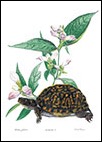
September 8
Turtlehead
(Chelone glabra)
This native plant is a perennial found in moist habitats of the eastern United States. Flowers resemble a turtle’s head. Stems can be more than three feet tall but usually sprawl across the stream banks or wet meadows where they bloom in late summer.
I keep a journal of where I find plants I hope to paint, and I record the dates that I find the first bloom and the last bloom of those plants. When I have a window of opportunity to paint, I look in my journal to see what plant is blooming, and where. I had recorded the turtlehead in August near a little spring across the street. When I went over there, I found the flowers were not quite ready to be painted but a little box turtle was in the wet area below the spring. Three days in a row it was the same story—not yet time to paint the flowers, and the turtle didn’t seem to have moved much. I took her home and offered her assorted things that a turtle might eat. She didn’t eat much but the next day she was feeling a little better. The day after that she felt great and was traveling all over the lawn at a pretty good speed (I think she had been poisoned by pesticides, herbicides and fertilizers).
So I said to her, “I’m going to paint your portrait.” I put her up on some boxes on my kitchen table where she stood very still, as though she understood, “chin up—hold that pose.” I worked on my painting on the table below as we listened to John Coltrane, Oscar Peterson, and a few symphonies together. Now and then we’d take a break out on the lawn where she would really strut around -- it felt so good to be well. Then, back in the kitchen-“chin up—hold that pose,” while she saw the image of a turtle emerge in my painting.
After I finished, I showed the portrait to her and took her down to the creek area on my side of the street—where there are no pesticides, herbicides, fertilizers or other poisons. No little turtle ever had the cultural experience that she had. I never saw her again but she had quite a story to tell.
(Click on the picture for a larger image)
(Click here for the next painting)


